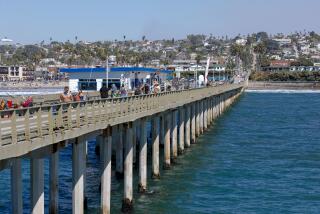Coastal Commission OKs Permit for Long Beach Port Terminal
Under intense political pressure, the California Coastal Commission on Wednesday approved a permit that will allow the Port of Long Beach to bury tons of contaminated silt offshore as part of the construction of a new shipping terminal.
The permit, which was to be approved last month but ran into unexpected objections from some commission members, was one of the last requirements needed before the port can start construction of a 145-acre terminal for its fastest-growing tenant, a Chinese shipping company. The permit was approved by an 8-1 vote.
Doubts over the project focused on the portâs plan to dredge about 3.7-million cubic yards of sediment from the West Basin to deepen berthing areas and approach channels for cargo ships at the new terminal. As part of that work, the port would dig out 730,000 cubic yards of contaminated silt, store it under five feet of clean sediment, and put it within a new shallow-water bird habitat for California least terns on the outer edge of the harbor.
Commission members said they voted for the permit over the strenuous objection of environmentalists because port officials had promised to provide more details of how they would dispose of the silt and to monitor water quality in the harbor after construction.
âI hope this doesnât come back to haunt us,â said commission Chairman Rusty Areias. âThis is not the way . . . Iâd prefer to conduct these proceedings.â
Long Beach officials have leaned on individual commission members heavily in the month since the panel first raised questions about the project. The port had hired the Los Angeles political consulting firm Cerrell Associates to lobby on its behalf, and Assemblyman Steve Kuykendall (R-Rancho Palos Verdes) and other state lawmakers have called various commission members to push for approval.
Mayor Beverly OâNeill told the commission the city needs the project to help it recover from massive defense industry layoffs over the last six years. Terminal construction will create about 1,600 temporary jobs and 650 permanent jobs, mostly for union longshoremen, as well as bring in about $1 million a year in city revenue, port officials say.
Environmentalists, who also lobbied the panel, said they were dealt a major defeat. Many had hoped the commission would be more receptive to their cause with the recent departure of several Republican-appointed members.
âThey have failed 23 million people in Southern California to make sure 650 have jobs,â said Bruce Monroe, a spokesman for the Sierra Club. âThatâs a violation of public trust.â
*
Monroe and other opponents of the project said the portâs plan to store the contaminated sediment underwater in a confined aquatic disposal (CAD) site is an unproven method that should be studied further before it is used. The Port of Los Angeles has constructed a confined aquatic disposal site for one of its construction projects, and the coastal panel may consider allowing a third site, at the mouth of the Los Angeles River.
Environmentalists also criticized the EPA and the Army Corps of Engineers, which still must sign off on the portâs plan, because the agencies had pledged two years ago to form a task force to analyze regional sediment management and study such disposal sites. After two years, the task force members have yet to agree on basic issues such as how the task force should be structured.
âThe jury is still out on whether CAD sites really work or not,â said commission member Sara Wan, who voted for the permit Wednesday despite her reservations.
Wan said she supported the permit because the port had agreed to take the most contaminated sediment to a landfill instead of the underwater site, to monitor the site for chemical seepage according to standards adopted for the L.A. portâs confined aquatic disposal site, and to monitor the new bird habitat.
The only commissioner to vote against the permit was Fran Pavley, who questioned the adequacy of the portâs plan to deal with the contaminants.
Port officials hailed the vote and said construction would likely begin in March. Building the terminal is expected to take 18 months at an accelerated pace, and if the project is not finished by July 1, 1998, the China Ocean Shipping Co. would be released from its lease and could pursue land at other ports.
More to Read
Sign up for Essential California
The most important California stories and recommendations in your inbox every morning.
You may occasionally receive promotional content from the Los Angeles Times.










